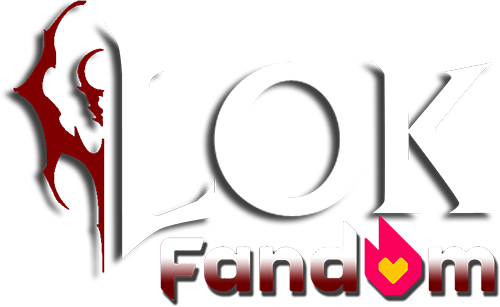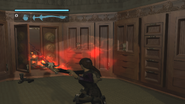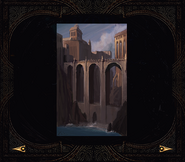The Tomb Raider franchise has been heavily related to the Legacy of Kain series from its earliest days, at times competing franchises, before sharing a publisher and ultimately a developer as well. The Legacy of Kain series has been often referenced in Tomb Raider games, particularly in the more recent entries which were developed by Crystal Dynamics and the remainder of the teams that worked on the Legacy of Kain series.
Profile[]
The original Tomb Raider game was published in the fall of 1996 by developer Core Design and publisher Eidos Interactive and shared the same release period as the original Blood Omen: Legacy of Kain - While Blood Omen was considered a surprise success, Tomb Raider was arguably a 'runaway smash hit' that largely redefined the genres of the era. Two more titles - Tomb Raider II and Tomb Raider III - were released while Silicon Knights and Crystal Dynamics underwent legal battles over the fate of the "Blood Omen" series - with Crystal Dynamics ultimately retaining ownership of the now "Legacy of Kain" series along with a new publisher - Tomb Raider backer Eidos.
Following this, Eidos slotted the two franchise into release patterns. Crystal's first 3D action adventure genre Legacy of Kain title - Legacy of Kain: Soul Reaver - was released in 1999, and it competed with the fourth Tomb Raider game The Last Revelation, with the two games frequently compared in the media. A fifth title Chronicles followed in 2000 as the Legacy of Kain teams at Crystal developed Soul Reaver 2 and Blood Omen 2, released in 2001 and 2002 respectively.
With the poorly received releases of Tomb Raider: Angel of Darkness and Legacy of Kain: Defiance in 2003, Core Design were relieved of the franchise and the rights given to Legacy of Kain developer Crystal Dynamics - leaving the Kain series in limbo as the Tomb Raider series branched into a new rebooted trilogy consisting of the Tomb Raider: Legend, Tomb Raider: Anniversary and Tomb Raider: Underworld (released in 2006, 2007 and 2008 respectively). These titles were developed by the team who had formally developed the Legacy of Kain series and included frequent references and Easter eggs related to the series.
After this trilogy, a multiplayer spin-off titled Lara Croft and the Guardian of Light included Kain and Raziel as playable characters in DLC content before the series was rebooted again beginning with 2013's Tomb Raider. A second spin off Lara Croft and the Temple of Osiris was released in 2014 before the second entry in the chronology Rise of the Tomb Raider (2015) which also featured a return of the Legacy of Kain references.
Related Games[]
Tomb Raider: Legend[]
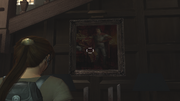
Kain's portrait in the Croft manor in Legend
Tomb Raider: Legend is the seventh game in the Tomb Raider franchise and the first to be developed by Crystal Dynamics (previous Tomb Raider games were developed by Core Design). Legend re-unites many of the developmental team that worked on the Legacy of Kain series and features many 'Easter Eggs' and other references to the Legacy of Kain series.
References to Legacy of Kain in Tomb Raider: Legend[]
- The Croft Manor (traditionally used as a 'training level') features a portrait of the Human Kain, first seen in Kain's Mausoleum in Legacy of Kain: Defiance.
- Upon game completion (or through the use of cheats) Lara Croft can wield the Soul Reaver in place of her usual pistols - in game it is treated the same as the 'Excalibur' sword.
- Several of the symbols used in the Legacy of Kain series are seen subtly hidden throughout Legend - including the symbols of the Sound Glyph, Kain/Kain's empire, Raziel/the Razielim and the skull of the Soul Reaver (as seen in the Balance fragment of the Balance Emblem) - with the outfits 'Goth' (presumably a reference to Nosgoth), 'Goth Lace', 'Sports', 'Sports Green' and 'Snowsuit' all including one or more hidden Legacy of Kain symbols. Daniel Cabuco's former site even included a guide to those in the 'Sports' outfit along with images of Lara Croft in front of a Mural seen in the Fire Forge in Legacy of Kain: Soul Reaver.
- Legend also features the concept of a legendary blade (in this case Excalibur) that is fractured and later re-assembled much like the Soul Reaver blade in Soul Reaver 2.
Gallery[]
Tomb Raider: Anniversary[]
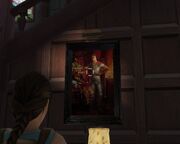
Kain's human portrait in the Croft Manor in Anniversary
Tomb Raider: Anniversary is the eighth game in the Tomb Raider franchise and the second to be developed by Crystal Dynamics. A remake of the original Tomb Raider game, Anniversary continued the continuity begun in Tomb Raider: Legend. As with Legend, Anniversary was developed by the remains of the team that worked on the Legacy of Kain series and featured several 'Easter Eggs' and other references to the series.
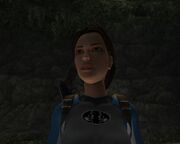
Raziel's clan symbol on the Wetsuit costume
References to Legacy of Kain in Tomb Raider: Anniversary[]
- As with Legend, The Croft Manor (traditionally used as a 'training level') still features the portrait of the Human Kain, first seen in Kain's Mausoleum in Legacy of Kain: Defiance.
- Raziel's clan symbol appears on the chest of the 'Wetsuit' costume - itself a reference to the 'Sola diving suit' from Tomb Raider 2.
Tomb Raider: Underworld[]
Tomb Raider: Underworld is the ninth game in the Tomb Raider franchise and the third to be developed by Crystal Dynamics, completing the trilogy established by Tomb Raider: Legend and Tomb Raider: Anniversary. As with Legend and Anniversary, Underworld was developed by the remains of the team that worked on the Legacy of Kain series and featured several 'Easter Eggs' and other references to the series.
References to Legacy of Kain in Tomb Raider: Underworld[]
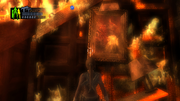
Kain's portrait aflame in the burning croft Manor
- As with Anniversary and Legend, The Croft Manor (traditionally used as a 'training level') still features a portrait of the Human Kain, first seen in Kain's Mausoleum in Legacy of Kain: Defiance.
- Underworld's story features Lara visiting several mythological Underworld locations; though they are depicted literally as sealed underground locations rather than a separate plane of existence.
- Several enemy variants seem similar to those in the Legacy of Kain series, with many appearing to derive from the same mythological concepts; although treated in a much more 'straightforward' fashion than Legacy of Kain enemies. These include "Giant spiders", the Octopus/Squid-like "Kraken" (which cannot be harmed by conventional means); perhaps most similar are the "Thrall" variant enemies - undead enemies raised by the liquid "etir" and having a notably similar 'decayed humanoid' appearance to the Legacy of Kain thralls.
- The 'Legendary Blade' concept returns as Excalibur (previously assembled from fractured pieces in Legend) makes a brief appearance in the final cutscene. A different 'Legendary weapon' - Thor's Hammer - can be collected and used in game; its attacks are similar to those used for Excalibur and the Soul Reaver in Legend.
- The end credits of Underworld begin with the dedication "For Kyle"; referring to the tragic death of developer Kyle Mannerberg who passed away around a year before the release of Underworld. Along with being credited as the lead level designer of Underworld, Kyle was one of the staff originally given custodianship of the Legacy of Kain series after the departure of Amy Hennig. A portrait of Mannerberg is also seen on Lara's yacht.
Lara Croft and the Guardian of Light[]
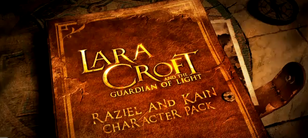
- "Meanwhile, in another World...and kind of in the past... "
- ―Raziel and Kain Character Pack introduction
Lara Croft and the Guardian of Light is an arcade-style video game developed by Crystal Dynamics. It is the tenth game in the Tomb Raider franchise (despite officially not being considered part of the franchise proper) and the fourth game developed by Crystal Dynamics. Significantly, Guardian of Light featured Downloadable content (DLC) that allowed Raziel and Kain to be used as playable characters for the first time since Defiance.
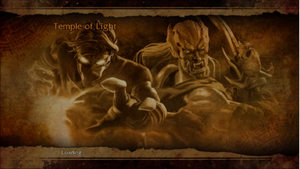
Guardian of Light is a fixed-camera 3D platform viewpoint action video game developed by Crystal Dynamics and published by Square Enix Europe for the PC, PlayStation Network, Xbox Live Arcade and the iOS as part of the Tomb Raider series (though it does not bear the "Tomb Radier" brand name and is not considered part of the franchise proper, fitting in between the continuity of Crystal Dynamics first Tomb Raider trilogy and the upcoming reboot). The game was made available only for digital download on 18 August 2010. Unlike previous games in the series which were third person adventure games, Guardian of light is an isometric based arcade shooter with a heavy emphasis on cooperative gameplay.
Downloadable content (DLC) was released for Guardian of Light between October and December 2010, including a "Raziel and Kain Character Pack", which replaced the main playable characters (Lara Croft and Totec) with Raziel and Kain respectively. Whilst In this mode, the dialogue between characters was replaced by excerpts from the Legacy of Kain series edited into a humorous storyline.
Plot[]
Raziel and Kain accidently release the dark god Xolotl who flees his prison to escape to the outside world. Raziel and Kain give chase in a desperate attempt to stop him before the sun rises. After taking different routes on several occasions, Raziel and Kain finally confront Xolotl as the sun rises and Kain personally finishes the dark lord.
Notes[]
- Slightly different cutscenes play in single player and multi-palyer modes
- In the opening cutscene, the text "meanwhile, in another world, and kind of in the past..." is treated with a similar visual effect to the text in the Defiance introduction, with a 'blur' then a 'stretch' effect behind the text.
- At the start of the "Temple of Light" level, Kain mentions the Sarafan Lord. Later on when in "Xolotl's Stronghold", Raziel asks whether they are "within the fortress of the Sarafan Priesthood", referencing both the Sarafan and the Sarafan Stronghold.
- Despite their co-operation in this storyline (and the fact it was Raziel that released Xolotl), Raziel is apparently convinced on several occasions that Kain is responsible for their dilemma or is manipulating his actions; culminating in an argument which ends with Kain lamenting, head in hands, "he had lost his mind".
- There are a few occasions where the dialogue does not match who is speaking - Kain shouts "never" with Michael Bell's voice (Raziel) in the opening scene and when encountering Xolotl's Frie Trap says "something is not right here" in an unidentified voice.
See also[]
 Lara Croft and the Guardian of Light at Wikipedia
Lara Croft and the Guardian of Light at Wikipedia- Official Lara Croft and the Guardian of Light Website
References[]
Rise of the Tomb Raider[]
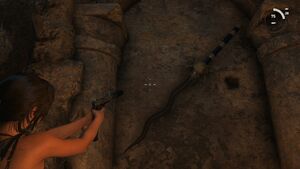
The Soul Reaver in Rise of the Tomb Raider
Rise of the Tomb Raider is the eleventh game in the main Tomb Raider Franchise and the second main game in the series since the 2013 reboot (itself the second reboot of the series). Rise was developed by Crystal Dynamics and the remains of the team that worked on Legacy of Kain: Defiance in 2003. Notably Rise featured the return of Legacy of Kain series Easter eggs after a five year absence.
References to Legacy of Kain in Rise of The Tomb Raider[]
After a number of Easter eggs and references in the previous continuity trilogy of Tomb Raider: Legend, Tomb Raider: Anniversary and Tomb Raider: Underworld - and guest appearances by Raziel and Kain in Downloadable content for the spin-off Lara Croft and the Guardian of Light - the next titles in the Tomb Raider franchise rebooted the series, but neither the 2013 reboot (titled simply "Tomb Raider") or the spin-off Lara Croft and the Temple of Osiris made any mention of the Legacy of Kain series.

The Raziel symbol in the Tomb Raider: Reloaded intro
The 2015 sequel Rise of the Tomb Raider returned to making references, with the Soul Reaver blade appearing in a secret area in the 'Tomb of the Prophet'. Once the game was completed, Lara could fast travel back to the level and use her grappler to reach an area on the top of the main pedestal, directly above the fast travel point. Here the Soul Reaver blade could be found embedded into a wall . Patterns apparently based upon the clan symbols were also featured in some places.
Updates in later DLC's also added new related content, with three cards appearing along with endurance mode that were related to the Legacy of Kain series. These included a "Raziel" card which granted extra 'warmth' for using melee finishers on enemies, a "Kain" card which granted extra food for using melee finishers and "half-vampire" card which allowed melee kills to regenerate health at the cost of no longer using bandages.
Tomb Raider: Reloaded[]
After a six year absence, LoK references returned to Tomb Raider in 2021, with a Raziel/Razielim symbol making an appearance in the intro to mobile game Tomb Raider: Reloaded by Emerald City Games. This is also marks the first reference in a title that was not directly developed by former Legacy of Kain developer Crystal Dynamics.
Tomb Raider I-III Remastered[]

Kain's portrait in the Tomb Raider 2 Manor
Tomb Raider I-III Remastered, also known as Tomb Raider 1-3 Remastered, was a remaster of the first three Tomb Raider games released in 2024 which was developed by Saber Interactive and published by Aspyr Media. Shortly after release it was confirmed that several member of the fam community - including known Legacy of Kain fans - had been involved in the development of the title and several references to the LoK series were included.
Most obviously the portrait of Kain from Legacy of Kain: Defiance was included in the Croft Manor of all three games. As it had previously appeared in the trilogy of Legend, Anniversary and Underworld the picture served to reference both the Legacy of Kain games and the LAU Tomb Raider trilogy developed by Crystal Dynamics. Several other Legacy of Kain Easter eggs were teased to be present.
Later discoveries by fans 'SkNero' and 'William Faure' exposed that several of Kory Heinzen's Legacy of Kain: Defiance environmental concept arts were among the paintings present in the Croft Manor, including illustrations of Vorador's Mansion, the Sarafan Stronghold and the Vampire Citadel.
Further Easter Eggs were still teased to be present but has yet to be revealed.
Notes[]
- Along with the games, both the Legacy of Kain and Tomb Raider franchises shared a comic publisher Top Cow - who published a long running Tomb Raider comic series as well as the Legacy of Kain: Soul Reaver comic and the Legacy of Kain: Defiance comic - both 'one-shot' deals . A preview edition published in 1999 featured preliminary artwork for the Soul Reaver comic and the Tomb Raider comic series.
